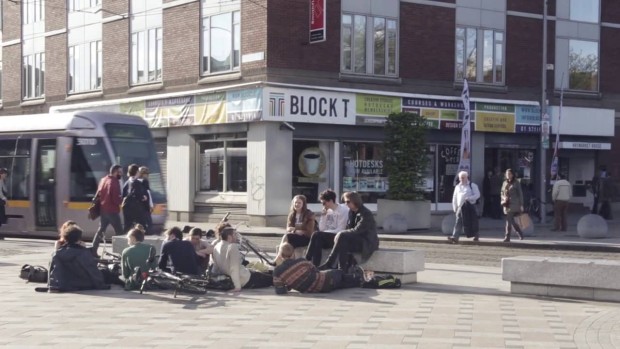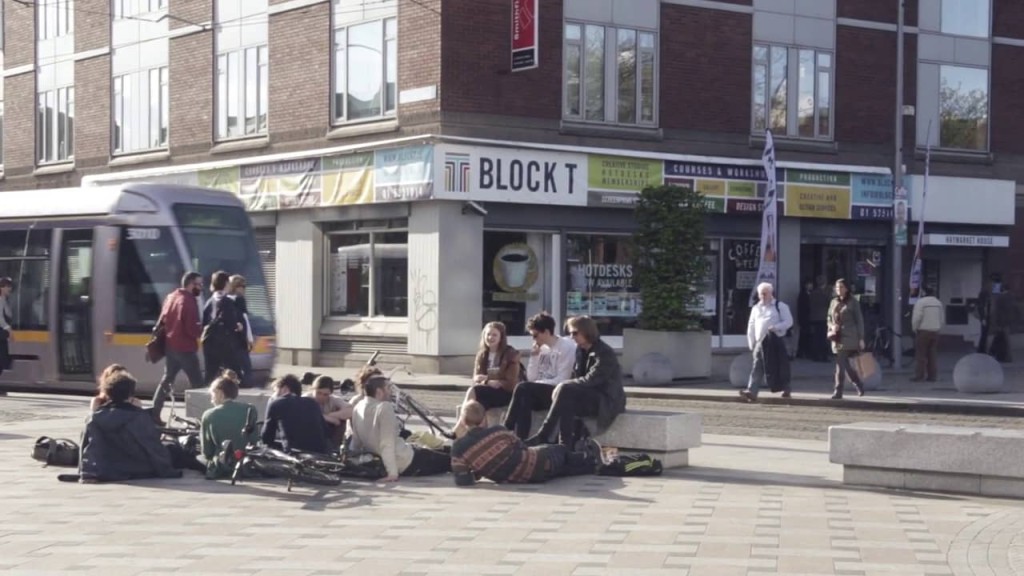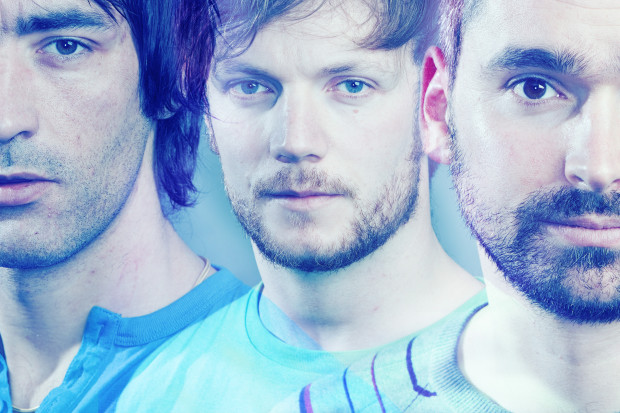As recession turns into a gloomy memory of Dublin’s past, development designs once shelved are being retrieved across the city, including former visions of grandeur for Dublin 7’s Smithfield. Development brothers Joe and Patrick Linders stand poised to helm the projects along the storied streets, having bought up properties throughout the area since before the crash years ago. In 2011, Dublin City Council denied them their plans to demolish the old Irish Distillers HQ and turn it into a corporate high rise. Now five years later, with reformed plans in hand as well as debt relief from a 2014 refinancing deal, the Linders are moving forward with proposals to convert the site into an office development. To some opportunists, the move means on and up for Smithfield as a cosmopolitan epicenter. To other niche enterprises, however, like the successful creative hub Block T, the move means on and out.
And yet the creative thinkers who started Block T don’t look at this new chapter with dismay. “It could be the best thing that’s ever happened to us,” says Laura Dovn, co-founder and managing director of Block T. Begun six years ago mid-recession, Block T is the brainchild of a group of graduates from the National College of Art and Design and friends they made, just across the river from their ramshackle Haymarket digs in Smithfield. Leaving college at that time was a daunting inevitability for early 20-somethings. Co-founder and programme director Grace McEvoy remembers being part of a ‘lost generation’ of not only degree holders, but arts-degree holders, slowly being tugged along the academic assembly line into a world of shut doors outside. Seeing little to no opportunities on the horizon, McEvoy, Dovn, and friends rose to the challenge and made opportunity for themselves, with an eclectic group of thinkers bringing a range of skill sets to the table. Four founders hailed from beyond the campus walls: a painter called Ben Readman, Block T hospitality manager Joe Salam, a teacher and artist named Lili Heller, and entrepreneurial business student Nick Linders. Meanwhile, McEvoy, Dovn, and fellow student Simon McKeagney found each other in college. Leaving the environment of a collective, creative community at NCAD, they “wanted to create a life jacket” for themselves, recalls McEvoy. Shrewd and willing to toil, the crew knew they couldn’t rely on public funding to get their start, so they got going on what they do best: producing, programming, and curating cultural events. Each worked on a volunteer basis in the early days, and together they forged a business model which took cues from non-profit schemes but turned itself into a ‘for profit—to reinvest’ template. Innovative from the start, their limited-shares business model wasn’t officially dubbed Designated Activity Company until 2014.
All was accomplished from their humble beginnings in Tully’s Tiles warehouse, and thus began their relationship with Smithfield. Through personal and business connections with their future landlords the Linders, these flexible, social entrepreneurs were sold on taking over some of the brothers’ vacant property. Block T needed space, Smithfield needed cultural regeneration; the rest is history. The decrepit warehouse was limited to 12 studios to house their artists and support their programming agendas. Cold, worn down, and proving impossible to renovate without many hoops to jump through, the place was just one of their many starting-gate obstacles. Still, the team worked and made it work. Sourcing every bit of revenue from their tireless start, they built up an evolving but growing enterprise which eventually moved into their nearby trappings in Haymarket House where they maintain a whopping 70 studios and roughly 120 artistic members. Big-time gigs with big-time partners saw Block T garner much deserved praise and attention. A 2013 arts-entrepreneurial award was a sure sign of emerging success for the young visionaries, and slowly but surely, the Linders allowed the group to take over the building floor by floor, each claimed space a new echelon of measured accomplishment.
Together, they were teaching their community and themselves that artists don’t have to be void of business acumen. “It’s funny…people see it as this really evil thing if you commercialise what you do, but you don’t have to lose your ethos and value in it,” observes Dovn. Amidst a generation that’s often condemned as spoiled apathetics who can’t handle rejection, the creators of Block T have proven with unwearied enthusiasm that such isn’t the case for them and their peers. What’s more is that they’ve not sloughed the cornerstone of what they do and why they do it, which is to plug back into their vibrant community. When asked about some of the work they’re most proud of, Dovn and McEvoy both agree wholeheartedly on the frenzied fanfare whirled up in 2012’s LINK Culturefest, a three-day programme which gathered Smithfield’s very own visual and performing artists to exhibition. Yet even beyond celebrating the talents of its concrete dwellings, Block T has managed to summon talent from across Ireland and Europe. Through their efforts, they’ve created a community of exchange, one where talent, drive, and ideas are transmitted across the stimulating space they’ve developed. Six laborious years have seen them replicate and expound on the communal values learned in college.
Still, not ignorant to reality, Block T knew its time in Haymarket House would eventually end. Though it came overnight, they quickly copped onto the upturn of the market and approached the Linders about how long they had until the big move out. The end of March marks their deadline, and though the triple-threat task of clearing space, finding new grounds, and remaining operational weighs down, the response of support from the public has kept the spirits of Block T aloft. They’re not defeated; they’re simply regrouping. Many look at this story and want to see artistry fallen victim yet again to the villainy of corporate greed, but to this developing team, facing and working with reality has been a requisite challenge for results from the beginning. Proponents of the creative sphere would discredit government bodies in not pressuring developers and planners into providing more cultural space alongside waves of office and apartment blocks. Meanwhile, officials like Dublin city arts officer Ray Yeates have recently given out that artists are a disjoint community who don’t know how to communicate and advocate for themselves. Speaking holistically on the issue, Block T’s Dovn weighs in that there are merits to both sides, a line of rationale which has served and will keep serving her group well. What she and McEvoy hope to see from this transition is what they’ve always hoped for Block T: to engage their community in conversation about and for the arts. Reflecting on these past few years of endless productivity, the two note that lobbying for arts in addition to everything else they’ve done is a task and a half. What’s needed in Ireland now is not only productive conversation on quantifying culture but defining culture and defining the values Ireland sees in fostering a healthy economy. They themselves see Block T as part of regenerative development, with the fruits of their efforts shepherding over 150,000 visitors into Smithfield alone, but quantifying the rest of their work and calculating a value for it is something else altogether. It requires public testaments of faith in what they do, and it’s why they’re reaching out for support, advice, and the right people to back them.
“We want to make sure we take the right steps to ensure we progress … but we know we can!” states Dovn. When asked about the plans for the next stage, both seem not just upbeat but excited to see what comes next. They mention the idea of buying space in order to give Block T more stability. The thought of building is even tossed around, a notion which could become a project to manage unto itself where architects and visual artists are brought in to design the feat, ponders McEvoy.
Though the future is uncertain at crossroads like this, what’s clear is that this striking crew of cultural developers are passionate for what they do and not simply the idea of it. Block T is the story of a generation prepared to make opportunity over waiting for it. Now moving forward into yet another unknown phase of innovation, their exciting narrative will continue to be marked by how they shift the way Ireland evaluates emerging artistic culture and its place in community. Joe Madsen
Keep track of the next chapter of Block T via their Facebook page.







